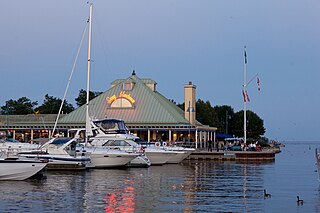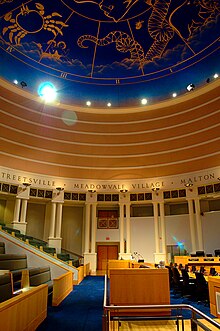
Brampton is a city in the Canadian province of Ontario. It is part of the Greater Toronto Area (GTA) and is a lower-tier municipality within Peel Region. The city has a population of 656,480 as of the 2021 Census, making it the ninth most populous municipality in Canada and the third most populous city in the Greater Golden Horseshoe urban area, behind Toronto and Mississauga.

Mississauga, historically known as Toronto Township, is a Canadian city in the province of Ontario, situated on the western shore of Lake Ontario in the Regional Municipality of Peel, adjoining the western border of Toronto. With a population of 717,961 as of 2021, Mississauga is the seventh-most populous municipality in Canada, third-most in Ontario, and second-most in the Greater Toronto Area (GTA) after Toronto itself. However, for the first time in its history, the city's population declined according to the 2021 census, from a 2016 population of 721,599 to 717,961, a 0.5 per cent decrease.

The Toronto City Hall, or New City Hall, is the seat of the municipal government of Toronto, Ontario, Canada, and one of the city's most distinctive landmarks. Designed by Viljo Revell and engineered by Hannskarl Bandel, the building opened in 1965. The building is located adjacent to Nathan Phillips Square, a public square at the northwest intersection of Bay Street and Queen Street, that was designed and officially opened alongside Toronto City Hall.

Bramalea (Bram-a-lee) is a large suburban district in the City of Brampton, Ontario, Canada. Bramalea was created as an innovative "new town", and developed as a separate community from the city. Located in the former Chinguacousy Township, it was Canada's first satellite community developed by one of the country's largest real estate developers, Bramalea Consolidated Developments.

Kitchener City Hall is the seat of municipal government of Kitchener, Ontario, Canada. It has gone through many iterations through the 20th century, culminating in the current building, which opened in 1993.

The Scarborough Civic Centre is a civic centre located in the Scarborough district of Toronto, Ontario, Canada. It was designed by architect Raymond Moriyama during the development of Scarborough City Centre and initially opened as the city hall of the former borough of Scarborough by then mayor Albert Campbell and Queen Elizabeth II in 1973. The building served as the municipal office and office for the Scarborough Board of Education. Following the amalgamation of Toronto, Scarborough lost its city status and the civic centre became a secondary hub for the City of Toronto government. It is also home to the Scarborough Community Council and offices of the Toronto District School Board.

The North York Civic Centre is a municipal government building in Toronto, Ontario, Canada. It opened in 1979 as the city hall of the former city of North York. It is located in North York City Centre.

The Etobicoke Civic Centre in the Eatonville neighbourhood of Toronto, Ontario, Canada, once housed the municipal government of the former City of Etobicoke.

The East York Civic Centre was the municipal office of the former borough of East York, now part of Toronto, Ontario, Canada as the result of municipal amalgamation. The two-storey civic buildings, located on the western side of Coxwell Avenue, were completed in 1990. Prior to 1990 it was the site of the East York Municipal Offices built in 1948, additions added in 1963 and 1975. The Township of East York Municipal Building was located nearby at 443 Sammon Avenue.

Cooksville is a neighbourhood in Mississauga in the Greater Toronto Area region of Ontario, Canada. It is centred around the intersection of Dundas Street and Hurontario Street near the eponymous Cooksville Creek.

Te Ngākau Civic Square is a public square in central Wellington, New Zealand, between the Wellington central business district to the north and the Te Aro entertainment district to the south. The square is bounded by Jervois Quay, Harris Street, Victoria Street and Wakefield Street

Shore Tilbe Perkins+Will, formerly Shore Tilbe Irwin & Partners (STIP), is a Canadian architecture firm based in Toronto, Ontario. Since its founding as Shore and Moffat in 1945, and later as Shore Tilbe Irwin & Partners, the firm has completed numerous buildings, complexes and master plans across Canada, as well as at locations in the United States and Bermuda. From early educational and residential projects, the firm rose to prominence in the early 1950s, winning Governor General's Medals in Architecture and commissions from the government of Ontario for departmental buildings, and it went on to design prominent landmarks such as Purdy's Wharf in Halifax, Nova Scotia, and the redesign of Nathan Phillips Square in Toronto. The firm's scope today mostly encompasses community centres, libraries, pharmaceutical laboratories, offices and university teaching buildings, although the firm has also completed religious spaces, corporate interiors and public plazas.

Following is an outline is for the history of Brampton, the fourth largest city in Ontario, Canada. European settlers arrived began to settle the area in the early 19th century, with Brampton being formally incorporated into a village in 1853.

The Markham Civic Centre is the city hall of the city of Markham, Ontario. The brick and glass Civic Centre was designed by architect Arthur Erickson with Richard Stevens Architects Limited and was opened on May 25, 1990. The entrances, except for the great hall entrance, are named after communities in Markham. The building is adjacent to an 11.5-hectare park with a large pond reflecting the south façade.

The architecture of Toronto is an eclectic combination of architectural styles, ranging from 19th century Georgian architecture to 21st century postmodern architecture and beyond.

Brampton City Hall is home to Brampton City Council and the departments of the city. It is located at the intersection of Wellington Street and Main Street in downtown Brampton.

Kwakiutl is a totem sculpture by Aboriginal Canadian artist Simon Charlie, which has caused controversy for its nudity over multiple decades of display in Chinguacousy Township, and later Brampton, both near Toronto in Ontario, Canada. Charlie, also known as Hwunumetse', later received the Order of Canada. The 9-foot-tall cedar wood sculpture is best known for its exposed male genitals.

The Old Town Hall was a former municipal facility at the corner of King Street and Rodney Street in Wigan, England. The building, which was demolished in September 2013, had been designated a Grade II listed building in 1990.

Mississauga City Centre is the downtown of Mississauga, Ontario, Canada. The downtown district is located generally at the intersection of Hurontario Street and Burnhamthorpe Road, centred around Square One Shopping Centre.

Castleford Civic Centre is a municipal building in Ferrybridge Road in Castleford, a town in West Yorkshire in England. The building, which was previously the offices and meeting place of the Municipal Borough of Castleford, is now used as a local events venue.






















